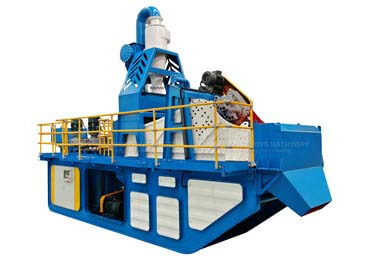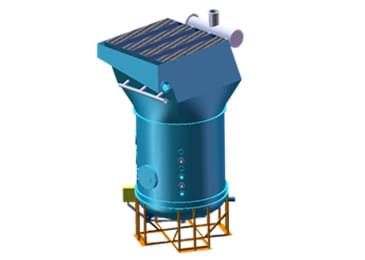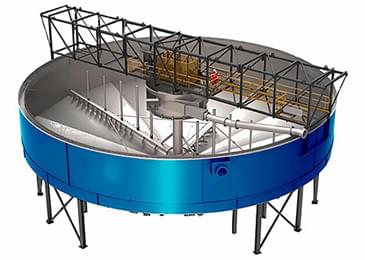Wastewater Treatment Method Of Concrete Mixing Plant
2021-07-28
With the rapid economic development, the concrete industry has also entered a new era, from the past mode of dust discharge, concrete tailings dumping, and wastewater dumping to the construction of green and environmentally friendly zero-discharge concrete mixing plants.
Speaking of concrete mixing plant wastewater treatment methods, we must first understand what are the components of concrete mixing plant wastewater? Wastewater contains concrete waste materials, sand, and gravel, silt water. The function of the tailings treatment facility is mainly to pull the leftover material from the construction site, clean the accumulated material in the mixer tank, and clean the waste material of the mixer after the tailings treatment facility is cleaned and separated, and then the separated sand, stone, and slurry are renewed. Treatment and reuse, to achieve the effect of zero or fewer emissions of the tailings of the mixing station. The production process of tailings treatment: collecting waste material-cleaning waste material-separating waste material-waste material reuse.The equipment used in the wastewater treatment method of concrete mixing plant, spiral sand washing and recycling integrated machine, thickening tank, filter press.
Wastewater treatment can be roughly summarized into the following categories.
1. Use the spiral sand washer to remove the sand and the water from the slurry
1) The tail sink of the spiral sand washer should be as large as possible to hold enough slurry water to clean the sand.
2) Considering the discharge of the mixer truck, it is generally installed in a sinking type, that is, installed below the ground. For example, when the new station is constructed, it can be considered as a whole to include the water for flushing the mixer.
3) The specifications of the spiral sand washer should not be too small. The processing time of the leftover material should be fully considered, which can be determined according to the scale of the mixing station and the number of mixing trucks. The concrete processing capacity of the spiral sand washer should not be too small to reduce or avoid the stuffiness of the equipment caused by the driver’s rapid discharge. It is necessary to fully communicate with the equipment manufacturer and select the appropriate power.
4) Due to the short cleaning time of this method, a small amount of slurry water will remain on the surface of the sand and gravel, and a long time will agglomerate and affect the discharge.
5) Since the sand and gravel are not separated, they can be used as coarse aggregate when reused. Therefore, it can only be used for low-grade concrete. For the building-type mixing plant, because the aggregate bin is on the top, if there is mixing in the bin, it will affect the production of high-grade concrete. If agglomeration can also affect the weighing, so be sure to avoid using this method.
The separated tail water needs to pass through the thickening tank for mud water separation operation. The generated clean water enters the clean water rotating pool directly from the overflow. At the same time, the mud at the bottom of the thickening tank is pumped into the filter press, and the concentrated mud is pressed into a mud cake by the filter press to achieve a dry pile for other purposes. After pressure filtration, the clean water also enters the clean water rotating tank to realize the recycling of clean water.
2. Use a vibrating screen to separate the stone, sand, and slurry water
The vibrating screen has a strong screening capacity, and this method is simple and effective. After the stone is separated, it can be reused, and the water after sedimentation of sand and slurry water can also be reused.
1) The terrain must have a certain drop in layout. The vibrating screen should be installed at a certain height, and the discharge height of the tailings discharge tank should be added. The tailings discharge tank should be considered to be cleaned by several mixer trucks at the same time. The drop should be reasonably arranged so that the remaining concrete in the tailings discharge trough can smoothly flush into the vibrating screen, and the leftover material pulled back by the mixer truck can be directly discharged on the vibrating screen, avoiding the discharge of concrete in the tailings. The phenomenon of material blockage due to poor flow in the trough occurs. This can reduce the labor intensity of workers and improve cleaning efficiency.
2) The discharge of the vibrating screen should be considered. If the vibrating screen is in a low position, a belt conveyor can be used to transport the stones out.
3) To clean the stones at one time, the amount of cleaning water should be large enough.
4) The amount of sand and mud exceeds that of stones, so sand and mud treatment methods must be implemented.
The vibrating screen can choose the commonly used circular vibrating screen or linear vibrating screen. The linear vibrating screen is suitable, which has the advantages of easy installation and convenient maintenance, which is convenient for the adjustment of the excitation force and the maintenance of the vibration exciter. The size of the vibrating screen is determined according to the size of the mixing station and the number of mixing trucks. The vibrating screen can be used with fine sand recovery equipment to reuse the recyclable sand and gravel. The separated tailwater is concentrated and filtered through a filter press so that the filtered clean water can be reused and drained.











